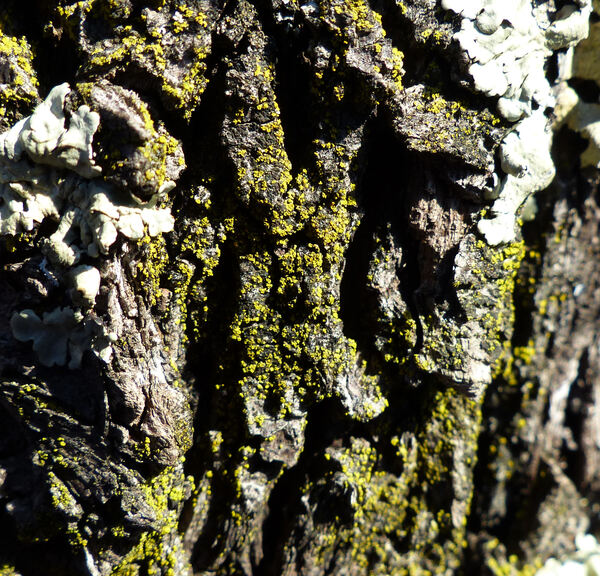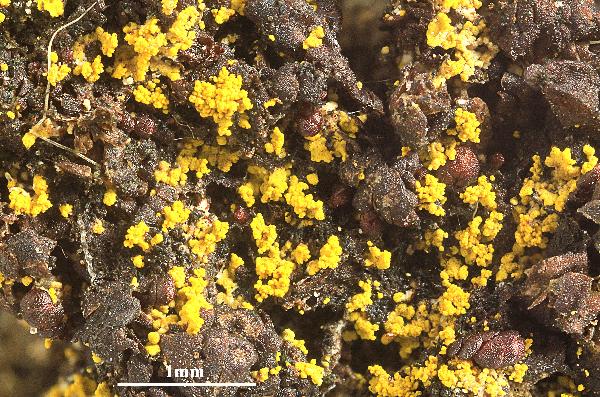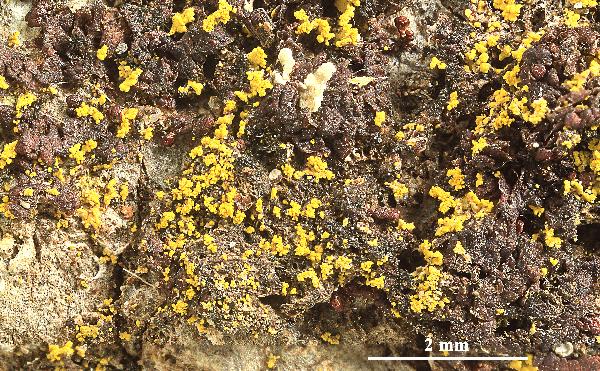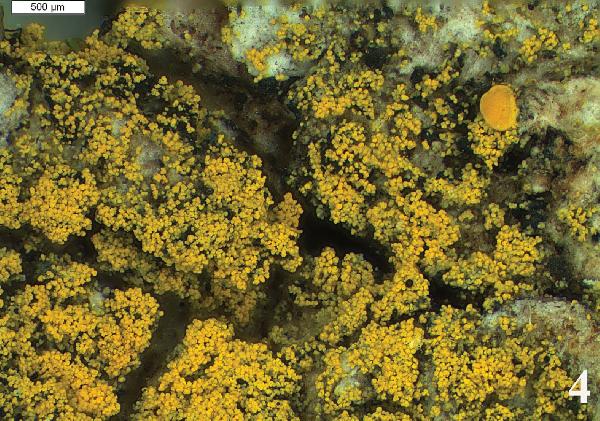Candelariella efflorescens R.C. Harris & W.R. Buck
Michigan Bot., 17: 155, 1978.
Synonyms:
Distribution: N - Frl, Ven (Thor & Nascimbene 2007, Nascimbene & Marini 2010, Nascimbene & al. 2012, 2015), TAA (Nascimbene & al. 2014, 2022, Nascimbene 2014), Lomb (Gheza & al. 2023). C - Mol (Ravera & Genovesi 2012, Genovesi & Ravera 2014). S - Camp (Ravera & al. 2019a), Bas (Potenza & al. 2014).
Description: Thallus crustose, formed by scattered, yellow-green to yellow, generally very small areoles which soon turn inapparent being obscured by soredia, rarely larger, apparent and up to 0.25 μm wide, with a 10-15 μm thick cortex consisting of 1-3 layers of more or less isodiametric cells. Soralia emerging from the areoles and zoon filling most of their surface, 0.15-0.4 mm across, at first convex and well-delimited, but soon confluent into a large, continuous sorediate crusts. Soredia 20-55 μm diam., yellow, composed of 10-15 photobiont cells irregularly surrounded by hyphae which often have a yellow-brown pigment. Apothecia rare, lecanorine, 0.2-0.4 mm across, with a flat to slightly convex, yellow-orange disc, and an up to 60 μm thick, irregular, often sorediate, sometimes excluded thalline margin. Thalline exciple with an indistinct pseudocortex, 4-9 um thick, of thin-walled non-gelatinized hyphae with isodiametric cells; proper exciple up to 45 μm thick in upper part, of radiating hyphae with rectangular cells; epithecium yellow-brown; hymenium colourless, 70-75 μm high; paraphyses simple or forked, septate, 1.5-2 μm thick, the apical cells cylindrical or clavate and up to 3 μm wide; hypothecium colourless. Asci 24-30-spored, clavate, with an apical dome which is I+ blue only in the internal, lower part, interrupted in the centre by a I+ paler blue strip, Candelaria-type. Ascospores 1-celled or rarely with a thin septum, hyaline, oblong to narrowly ellipsoid, 10-15 x 3.5-5.0 μm, often poorly developed. Photobiont chlorococcoid. Spot tests: K-, C-, KC-, P-. Chemistry: pulvinic acid derivatives. Note: on isolated trees, especially in orchards, certainly more widespread in the Alps. This taxon is apparently similar to C. reflexa, but the soredia are farinose, well-delimited, punctiform, and they never develop from a subsquamulose thallus. Some records could refer to the recently-described C. pulchella. For further details see Van der Kolk & al. (2025).
Growth form: Crustose
Substrata: bark
Photobiont: green algae other than Trentepohlia
Reproductive strategy: mainly asexual, by soredia, or soredia-like structures (e.g. blastidia)
Commonnes-rarity: (info)
Alpine belt: absent
Subalpine belt: absent
Oromediterranean belt: absent
Montane belt: extremely rare
Submediterranean belt: rare
Padanian area: absent
Humid submediterranean belt: very rare
Humid mediterranean belt: extremely rare
Dry mediterranean belt: absent

Predictive model
Herbarium samples


Andrea Moro; Owner: Department of Life Sciences, University of Trieste
italy, Friuli Venezia Giulia, Trieste, Trieste Karst near Borgo Grotta Gigante
16/02/2017


Felix Schumm - CC BY-SA 4.0
[ABL13666], Brazil, São Paulo, Botucatu, Botanical garden on campus.
On bark in park. 22°53'09'' S, 48°29'56'' W, 850 m. Leg. M.
Cáceres & A. Aptroot (no 13666), 13 Sept. 2012, det. A. Aptroot 2012.
Growth form: Crustose
Substrata: bark
Photobiont: green algae other than Trentepohlia
Reproductive strategy: mainly asexual, by soredia, or soredia-like structures (e.g. blastidia)
Commonnes-rarity: (info)
Alpine belt: absent
Subalpine belt: absent
Oromediterranean belt: absent
Montane belt: extremely rare
Submediterranean belt: rare
Padanian area: absent
Humid submediterranean belt: very rare
Humid mediterranean belt: extremely rare
Dry mediterranean belt: absent

Predictive model
| Herbarium samples |


Andrea Moro; Owner: Department of Life Sciences, University of Trieste
italy, Friuli Venezia Giulia, Trieste, Trieste Karst near Borgo Grotta Gigante
16/02/2017


 INDEX FUNGORUM
INDEX FUNGORUM
 GBIF
GBIF
 DOLICHENS
DOLICHENS




